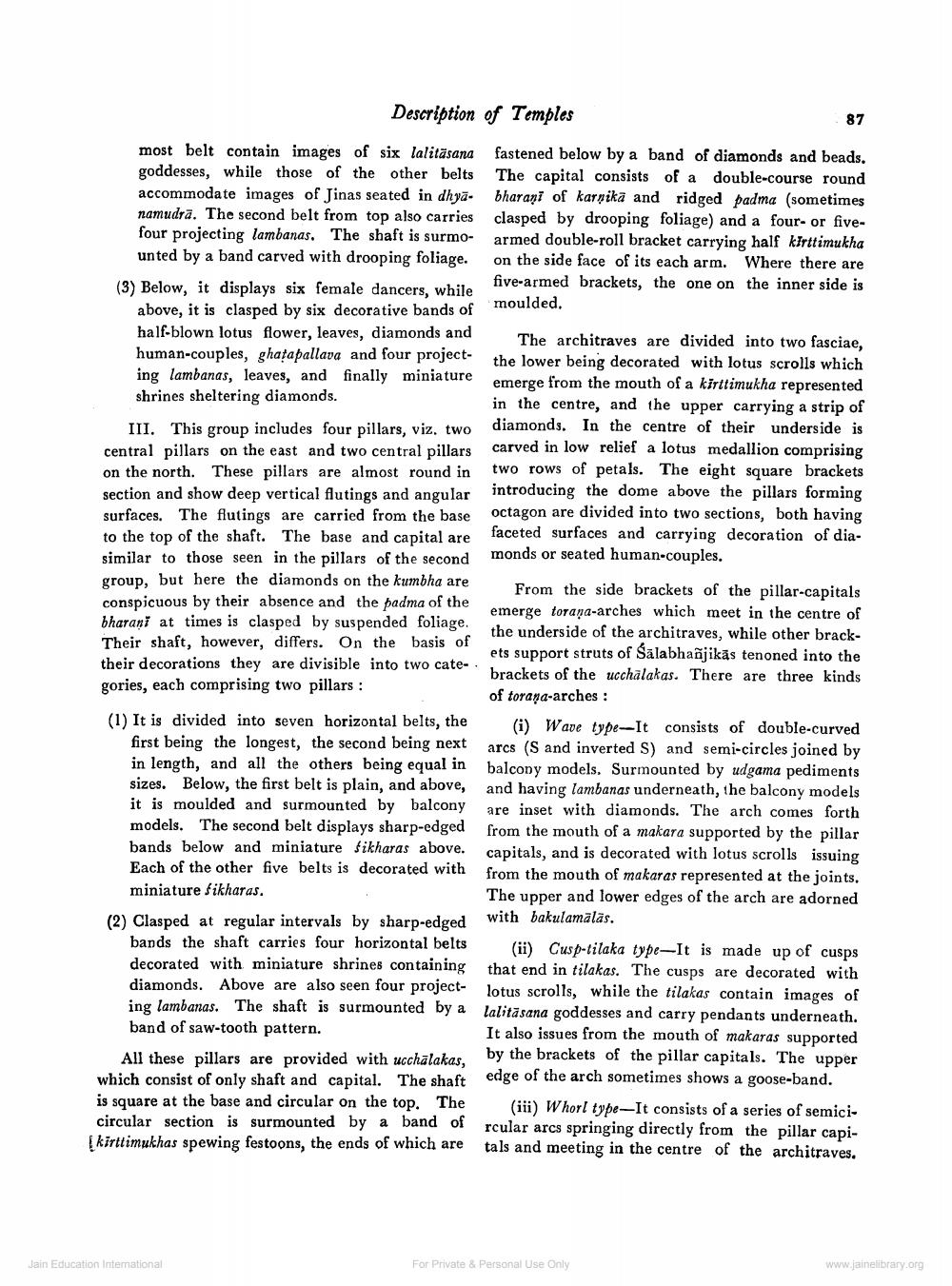________________
Description of Temples
87
most belt contain images of six lalitäsana fastened below by a band of diamonds and beads. goddesses, while those of the other belts The capital consists of a double-course round accommodate images of Jinas seated in dhyā bharani of karnika and ridged padma (sometimes namudra. The second belt from top also carries clasped by drooping foliage) and a four- or fivefour projecting lambanas. The shaft is surmo- armed double-roll bracket carrying half kirttimukha
unted by a band carved with drooping foliage. on the side face of its each arm. Where there are (3) Below, it displays six female dancers, while
five-armed brackets, the one on the inner side is above, it is clasped by six decorative bands of moulded. half-blown lotus flower, leaves, diamonds and
The architraves are divided into two fasciae, human-couples, ghatapallava and four project
the lower being decorated with lotus scrolls which ing lambanas, leaves, and finally miniature
emerge from the mouth of a kirttimukha represented shrines sheltering diamonds.
in the centre, and the upper carrying a strip of III. This group includes four pillars, viz. two diamonds. In the centre of their underside is central pillars on the east and two central pillars carved in low relief a lotus medallion comprising on the north. These pillars are almost round in two rows of petals. The eight square brackets section and show deep vertical flutings and angular introducing the dome above the pillars forming surfaces. The flutings are carried from the base octagon are divided into two sections, both having to the top of the shaft. The base and capital are
faceted surfaces and carrying decoration of diasimilar to those seen in the pillars of the second monds or seated human-couples. group, but here the diamonds on the kumbha are
From the side brackets of the pillar-capitals conspicuous by their absence and the padma of the
emerge toraņa-arches which meet in the centre of bharani at times is clasped by suspended foliage.
the underside of the architraves, while other brackTheir shaft, however, differs. On the basis of
ets support struts of Sālabhanjikās tenoned into the their decorations they are divisible into two cate-.
brackets of the ucchālakas. There are three kinds gories, each comprising two pillars :
of toraņa-arches : (1) It is divided into seven horizontal belts, the (i) Wave type--It consists of double-curved
first being the longest, the second being next arcs (S and inverted S) and semi-circles joined by in length, and all the others being equal in balcony models. Surmounted by udgama pediments sizes. Below, the first belt is plain, and above, and having lambanas underneath, the balcony models it is moulded and surmounted by balcony are inset with diamonds. The arch comes forth models. The second belt displays sharp-edged from the mouth of a makara supported by the pillar hands below and miniature Sikharas above. capitals, and is decorated with lotus scrolls issuing Each of the other five belts is decorated with
from the mouth of makaras represented at the joints. miniature fikharas.
The upper and lower edges of the arch are adorned (2) Clasped at regular intervals by sharp-edged with bakulamālās.
bands the shaft carries four horizontal belts (ii) Cusp-lilaka type-It is made up of cusps decorated with miniature shrines containing that end in tilakas. The cusps are decorated with diamonds. Above are also seen four project- lotus scrolls, while the tilakas contain images of ing lambanas. The shaft is surmounted by a lalitāsana goddesses and carry pendants underneath. band of saw-tooth pattern.
It also issues from the mouth of makaras supported All these pillars are provided with ucсhalakas. by the brackets of the pillar capitals. The upper
ft and capital. The shaft edge of the arch sometimes shows a goose-band. is square at the base and circular on the top. The (iii) Whorl type-It consists of a series of semicicircular section is surmounted by a band of rcular arcs springing directly from the pillar capiIkirttimukhas spewing festoons, the ends of which are tals and meeting in the centre of the architraves.
Jain Education International
For Private & Personal Use Only
www.jainelibrary.org




